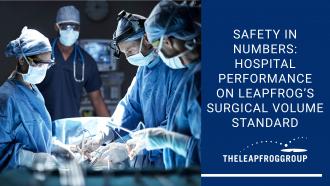
WASHINGTON D.C. - The Leapfrog Group, an independent national health care watchdog organization, today released Safety In Numbers: Hospital Performance on Leapfrog’s Surgical Volume Standard Based on Results of the 2019 Leapfrog Hospital Survey. The report analyzes whether hospitals are performing a sufficient volume of high-risk surgeries to safely do so, and whether the hospital grants privileges only to surgeons meeting the Leapfrog minimum volume standard. The report also records whether hospitals actively monitor to assure that each surgery is necessary.
Highlights from the 2019 report include:
- The majority of hospitals are still electively performing high-risk procedures without the adequate, ongoing experience to do so.
- There has been improvement: a higher percentage of hospitals are meeting Leapfrog’s minimum volume standards in 2019 than 2018.
- To the credit of rural hospitals, the vast majority do not perform these high-risk surgeries. Those that do are much less likely than other hospitals to meet the volume standard for patient safety.
- A sizeable percentage of hospitals have implemented protocols to monitor for appropriateness, potentially protecting patients from getting unnecessary surgeries.
“The good news is we are seeing progress on surgical safety. The bad news is the vast majority of hospitals performing these high-risk procedures are not meeting clear volume standards for safety. This is very disturbing, as a mountain of studies show us that patient risk of complications or death is dramatically higher in low-volume operating rooms,” said Leah Binder, president and CEO of The Leapfrog Group. “It’s time for hospitals and health systems to upgrade their surgical volume policies. It will save lives.”
Safety In Numbers uses final hospital data from the 2019 Leapfrog Hospital Survey, the flagship initiative of The Leapfrog Group. More than 2,100 hospitals participated in the 2019 Survey, representing 70% of U.S. hospital beds. Since 2018, Leapfrog has publicly reported on hospital performance in meeting minimum volume standards for safety of eight high-risk procedures.
The eight surgeries included in the Survey were identified by Leapfrog’s National Inpatient Surgery Expert Panel as procedures for which there is a strong volume-outcome relationship. The Expert Panel relied on published research and evidence to advise on minimum hospital and surgeon volume standards for each procedure.
Of the eight high-risk procedures assessed in the report, esophageal resection for cancer and pancreatic resection for cancer are the two procedures where the fewest hospitals met the volume standard for patient safety – less than 3% and 8% respectively. The procedure for which hospitals were most likely to meet the safety standard was bariatric surgery for weight loss (48%). Additionally, the report’s analysis shows that while many rural hospitals are doing the right thing by not performing these procedures, those that continue to do so are not likely to meet the volume standards.
Equally important to achieving minimum volume standards is avoiding unnecessary and unneeded surgeries. In this regard, Survey findings show that 70% of reporting hospitals have in place protocols to ensure appropriateness for cancer procedures. For other high-risk procedures evaluated on the Survey, hospital compliance to ensuring appropriateness ranged from 32-60%, depending on the procedure.
“It is critical that hospitals do not perform surgery when the procedure is not appropriate for the patient,” said Binder. “In addition to the increased potential for harm to patients, unnecessary surgeries contribute to the burden of overuse and excess expense in the U.S. health care system.”
Binder cited an October 2019 retrospective literature study in JAMA that found the estimated cost of waste in the U.S. health care system due to overtreatment or low-value care ranged from $75.7 billion to $101.2 billion.
In addition to the report released today, individual hospital results on surgical volumes and surgical appropriateness are freely available and searchable at www.leapfroggroup.org/compare. More information about the importance of minimum surgical volumes for safety are available on Leapfrog’s website at www.leapfroggroup.org.
